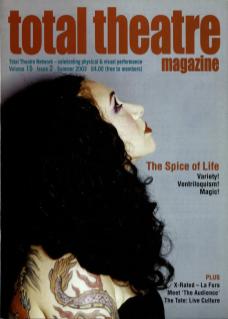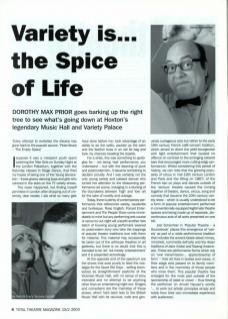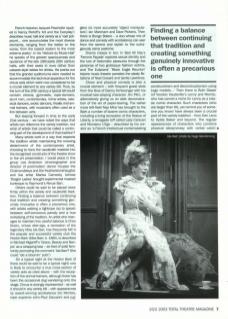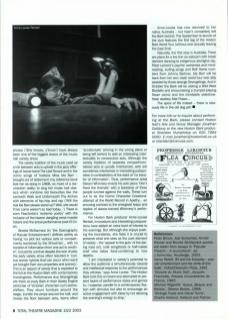'Every attempt to revitalise the theatre has gone back to the popular source.' Peter Brook – The Empty Space
I suppose it was a misspent youth spent watching the Tiller Girls on Sunday Night at the London Palladium, together with the Saturday classes in Stage Dance, that fired my hopes of being one of the Young Generation – those groovy dancing boys and girls who ushered in the stars on the TV variety shows.
This never happened, but finding myself penniless in London after dropping out of university, dear reader, I did what so many gals have done before me: took advantage of an ability to do the splits, packed up the satin and the feather boas in an old kit bag and took my chances treading the boards.
For a while, this was something to apologise for – not being ‘real' performance, you understand – but with the dawning of punk and postmodernism, it became something to declaim proudly. And I was certainly not the only young variety and cabaret dancer who turned her attention to the blossoming performance art scene, indulging in a blurring of the boundaries between 'high' and 'low' art for the sake of novelty and outrage.
Today, there is plenty of contemporary performance that references variety, vaudeville and burlesque. Rose English, Forced Entertainment and The People Show come immediately to mind but any performing arts course or venue try-out night will unearth another new batch of knowing young performers weaned on postmodern irony who take the trappings of popular theatre traditions and milk them for material. This material may occasionally be taken out of the arthouse theatres or art galleries, but there is no doubt that this is intended to be 'art' not merely entertainment and it is presented accordingly.
At the opposite end of the spectrum are the shows that exist purely to feed the nostalgia for the Good Old Days – selling themselves as straightforward pastiche of the Victorian Music Hall, with no sense of irony intended and no attempt to be anything other than an entertaining night out. Singers and comedians are the mainstay of these shows, which hark back less to the British Music Hall with its raucous, rude and genuinely outrageous acts but rather to the early 19th Century French café-concert tradition, which aimed to divert the petit-bourgeoisie with light entertainment that caused no offence (in contrast to the emerging cabaret bars that encouraged more cutting-edge performance). Whilst considering this period of history, we can note that the growing popularity of circus in mid-19th Century London and Paris and the lifting (in 1867) of the French ban on plays and dances outside of the 'serious' theatre caused the coming together of theatre, dance, circus, song and comedy that became the 20th Century variety show – which is usually understood to be a form of popular entertainment performed in conventionally equipped legitimate theatre spaces and being made up of separate, discontinuous acts of all sorts presented on one bill.
Joel Schechter in Popular Theatre – a Sourcebook places this emergence of ‘variety' as part of a noble performance tradition that includes the ancient Greek street mimes, minstrels, commedia dell'arte and the Asian traditions of Jatra (India) and Topeng (Indonesia). These are performance forms which rely on 'oral transmission... apprenticeship of form' – their art lives in bodies and voices, in their stage acts passed on to family members and in the memories of those people who know them. This popular theatre has emerged for the most part outside of the sponsorship of state or crown – thus freeing the performer (in Arnold Hauser's words) ‘... to work out artistic principles simply and solely from their own immediate experience with audiences'.
French historian Jacques Feschotte (quoted in Nancy Perloff's Art and the Everyday) describes music hall and variety as a 'vast potpourri... one accumulates the most diverse elements, ranging from the better to the worse, from the basest realism to the most extreme poetry’. In his Histoire du Music-Hall he speaks of the greater spaciousness and opulence of the late 19th / early 20th Century halls, with their seats in rows rather than cabaret-style tables for drinks. He points out that the grander auditoriums were needed to accommodate the technical apparatus for the circus acts which were now considered to be a crucial element to any variety bill. Thus, by the turn of the 20th Century a typical bill would contain clowns, gymnasts, rope-dancers, stunt men, contortionists, mime artists, classical dancers, exotic dancers, freaks and animal trainers, with musicians often used as a link between acts.
But leaping forward in time to the early 21st Century – we have noted the ways that artists can reference the variety tradition, but what of artists that could be called a continuing part of the development of that tradition?
Many artists work in a way that respects the tradition whilst maintaining the knowing detachment of the contemporary artist, choosing to hone the vaudeville material into the recognised constructs of the theatre show or live art presentation. I would place in this group Lea Anderson (choreographer and director of postmodern dance troupes the Cholmondeleys and the Featherstonehaughs) and live artist Marisa Carnesky (whose Dragon Ladies brought experimental masked burlesque to Raymond's Revue Bar).
Others could be said to be placed more firmly within the variety and vaudeville tradition. Finding a balance between continuing that tradition and creating something genuinely innovative is often a precarious one, with artists walking a tightrope (so to speak) between self-conscious parody and a true revitalising of the tradition. An artist who manages to maintain this careful balance is Chris Green, whose alter-ego, a recreation of the legendary Miss Ida Barr, has frequently MC'd the popular and successful variety club the Hoxton Bark (Miss Barr, b. 1884, is described in Michael Kilgarriff's Grace, Beauty and Banjos as a strapping lass – six feet of solid femininity, prompting the comment 'Ida Barr? She could ’ide a bloomin' pub!)
On a typical night at the Hoxton Bark (if there could be said to be a typical night) one is likely to encounter a true cross-section of variety acts as cited above – with the exception of the animal trainers, although there has been the occasional dog wandering onto the stage. Circus is strongly represented, as well it should in any variety bill – with appearances by award-winning acrobalance trio Mimbre, rope supremo John-Paul Zaccarini and jugglers (or more accurately 'object manipulators') Ian Marchant and Dave Pickens. Then there is Bongo Bolero – a duo whose mix of dance and comedy with acrobalance can veer from the serene and stylish to the outrageously camp pastiche.
Drama creeps in too: In Bed All Day's Femme Façade explores sexual identity and the lure of hedonistic pleasures through the personae of two grotesque fashion victims, and in The Eulipians' Black Eagle Reunion bizarre music theatre parodies the steely flirtations of Noel Coward and Gertie Lawrence.
Clown and physical comedy is also a crucial element – with frequent guest slots from the likes of Danny Schlesinger with his musical-saw-playing character Jim Plim, or alternatively giving us an able demonstration of the art of paper-tearing. The rather more left-field Feja Mira has brought to the Bark a number of bizarre comic characters, including a living recreation of the Statue of Liberty, a renegade toff called Lady Caravan and Monsieur L'Ego – described by his creator as 'a French intellectual contemplating constructivism and deconstructionism using Lego models...' Then there is Ruth Glaser (of Voodoo Vaudeville's Lenny and Morris), who has carved a niche for Lenny as a classic comic character. Such characters (who are larger than life, yet remind you of someone you know) have always been a crucial part of the variety tradition – from Dan Leno to Hylda Baker and beyond. The regular appearances of characters who combine physical idiosyncrasy with verbal catchphrase ('She knows, y'know') have always been one of the biggest draws of the music hall variety show.
The variety tradition of live music used as a link between acts is upheld in the jazzy offerings of house band The Last Tenant and in the comic songs of hostess Miss Ida Barr – brought out of retirement (my reference book lists her as dying in 1968, so more of a resurrection really) to sing her music hall classics which combine old favourites like The Lambeth Walk and Underneath The Arches with elements of hip-hop and rap (‘Will the real Ida Barr please stand up? Well, she would if her corns weren't so bad today...') There is even Feschotte's extreme poetry with the inclusion of the bizarre dangling verse master Solaris and the lyrical performance poet El Crisis.
Brooks McNamara (in 'The Scenography of Popular Entertainment') defines variety as having 'no plot but various acts or compartments combined by the Showman... with no transfer of information from one act to another', but points out that despite the lack of plot, the early variety show often resulted in 'curious scenic hybrids that can occur when each act brought their own properties and scenery’. This is an aspect of variety that is exploited to the full at the Hoxton Bark with contemporary knowingness. Performance duo Strangelings are there at every Bark in their Gaiety Engine personae of Victorian showmen-cum-sceneshifters. They shunt furniture around the stage, trundle the props around the hall, and sweep the floor between acts, items often 'accidentally’ arriving in the wrong place or being left behind to add an interesting intertextuality to consecutive acts. Although the variety tradition of separate compartmentalised acts is usually maintained, acts are sometimes intertwined in interesting juxtaposition in contradiction of the edict of no transfer of information. Thus, performance artist Steven Whinnery enacts his solo piece Don't Feed the Animals with a backdrop of three people lurched against the walls. These turn out to be the Comic Character Creations attempt at the World Record in Apathy... an amusing contrast to the energised leaps and ripples of dance-trained Whinnery's performance.
For Hoxton Bark producer Anne-Louise Rentell, innovations and interesting juxtapositions have added an extra level of interest to the evenings. But although she enjoys pushing the boundaries, she feels it is crucial to preserve what she sees as the core element of variety – the 'appeal to the guts' of the daring rope act, rude songstress or half-naked chef who takes food-combining to new depths.
‘I am interested in variety's potential to allow the audience a simultaneously visceral and intellectual response to the performances they witness,' says Anne-Louise. The Hoxton Bark took this on board and attempted to present layers of performance styles and genres to, I suppose, pander to a contemporary fixation with stimulus but also to encourage an active engagement with ideas by not allowing the evening's energy to drop.
Anne-Louise has now returned to her native Australia – but hasn't completely left the Bark behind. The September re-launch of the club features the first leg of the Hoxton Bark World Tour (without ever actually leaving the East End).
Naturally, the first stop is Australia. There are plans for a live link via webcam with break dancers dancing to indigenous aborigine rap, Peter Lamont's psychic weirdness and mindreading, surfing songs and Rolf Harris numbers from Johnny Berliner. Ida Barr will be back from her own (real) world tour ever ably assisted by those strange Strangelings. And in October the Bark will be visiting a Wild West Bordello and encountering a trumpet playing Texan comic and the inimitable sideshowfreak sealboy Mat Fraser...
The spice of life indeed – there is obviously life in the old dog yet!
For more info or to inquire about performing at the Bark, please contact Hoxton Hall's Arts and Venue Manager Jonathan Salisbury or the new Hoxton Bark producer Sheridan Humphreys. E-mail Jonathan@hoxtonhall.co.uk or sheridan@cvenues.com.
References: Peter Brook, Joel Schechter, Arnold Hauser and Brooks McNamara quotes are taken from essays in Popular Theatre - A sourcebook, ed. J.Schechter, Routledge, 2003. Nancy Perloff, Art and the Everyday - popular entertainment and the circle of Eric Satie, Oxford/Clarendon Press, 1991. Histoire du Music Hall, Jacques Feschotte, Presses Universitaires de France, 1965. Michael Kilgarriff, Grace, Beauty and Banjos, Oberon Books, 1998. Strange Feats and Clever Turns, Charlie Holland, Holland and Palmer.



